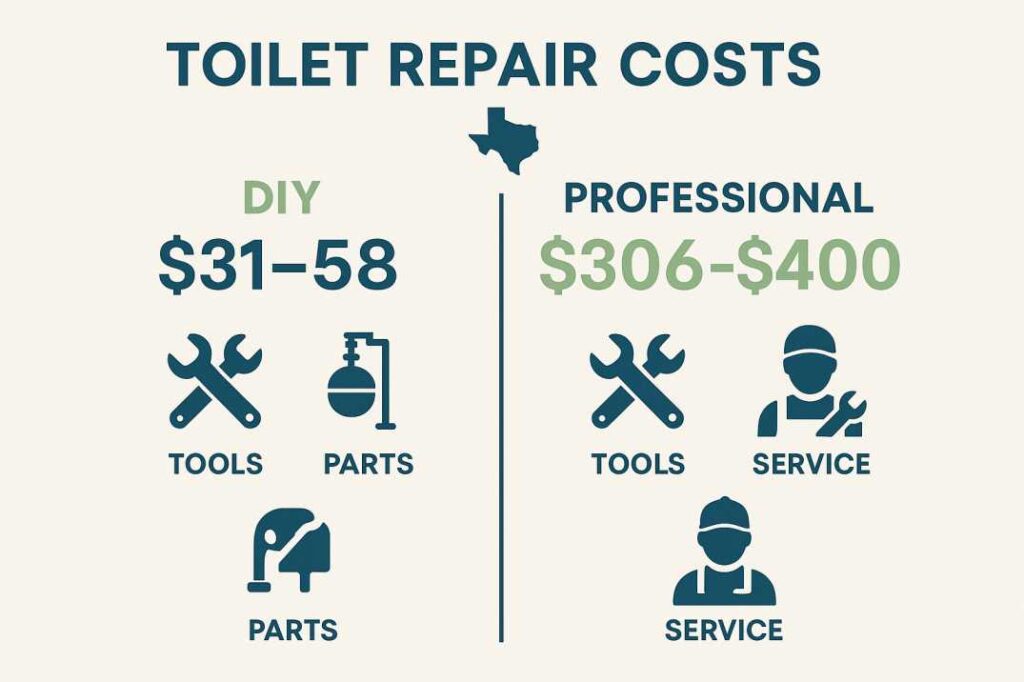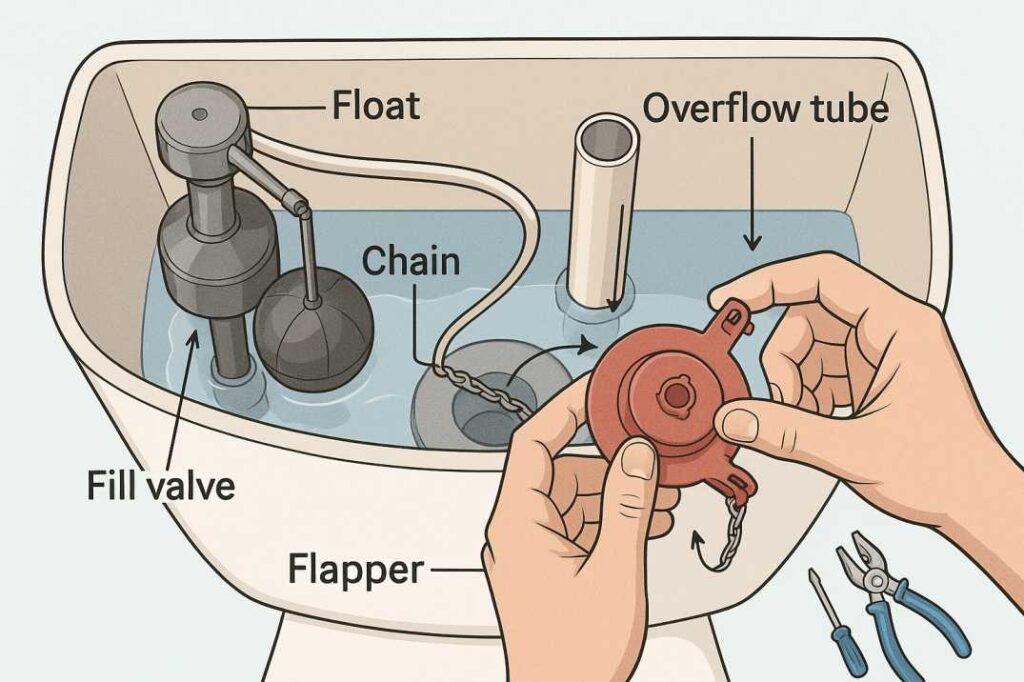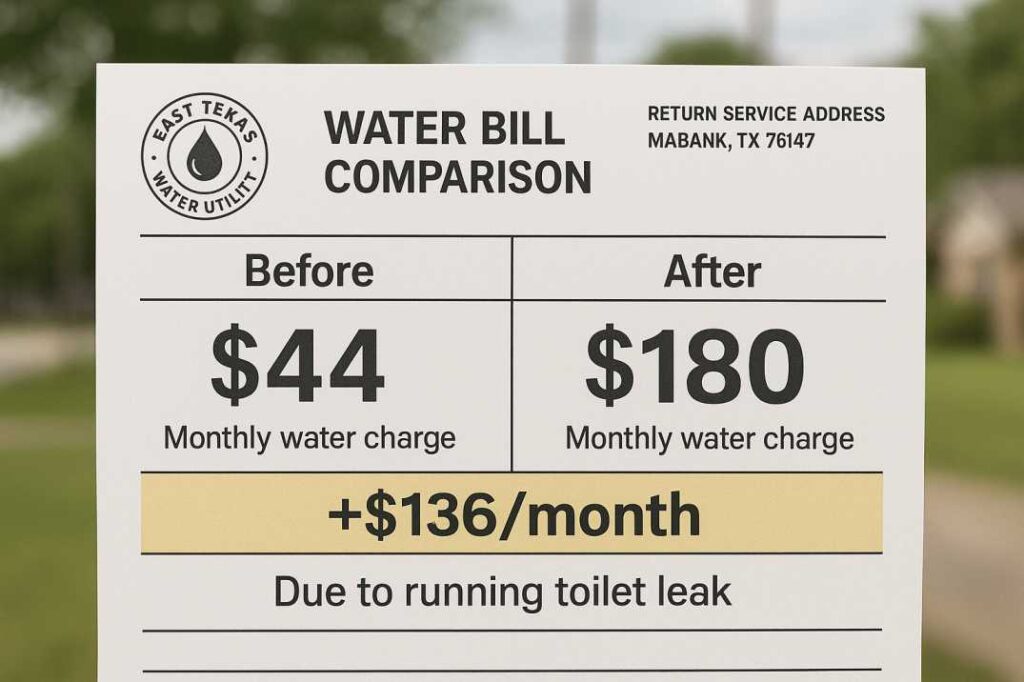Bottom Line Up Front: A running toilet can waste 200+ gallons daily (up to 30,000 gallons monthly), adding $70-$2,000 annually to your water bill. Most toilet leak cost calculations show DIY toilet repair saves thousands—basic repairs cost just $8-$50 in parts, making this one of the most cost-effective home repairs you can tackle.
Here’s what every Mabank homeowner should know about that constantly running toilet in your bathroom—it’s flushing your hard-earned money down the drain. Learning how to fix running toilet problems yourself can save you hundreds this year alone.
As your trusted local East Texas plumber, I see this issue frequently in our community. That “harmless” trickling sound you’ve been ignoring could be costing you hundreds or even thousands of dollars each year in wasted water. The EPA reports that a leaking toilet can waste about 200 gallons daily. Understanding the true toilet leak cost is crucial—the good news? Most running toilet problems are surprisingly easy to fix running toilet issues yourself, often requiring nothing more than an $8 flapper replacement.
Table of Contents
ToggleThe True Toilet Leak Cost of Ignoring a Running Toilet
Your Water Bill Impact
A running toilet can waste an entire gallon of water in just 30 seconds. Here’s what that means for your monthly water bill:
- Small leak: 30-250 gallons daily = $70+ extra monthly
- Medium leak: 250-1,000 gallons daily = $200+ extra monthly
- Large leak: 1,000-4,000+ gallons daily = $400+ extra monthly
Real East Texas Example: Last month, I helped a Mabank family whose toilet had been running for three months. Their water bill jumped from $44 to $180 monthly—that’s $408 in wasted water costs for a problem that took me 10 minutes to fix running toilet with an $8 flapper. This toilet leak cost them over $400 when a simple DIY toilet repair could have solved it immediately.
Environmental Impact
According to EPA WaterSense studies, toilet leaks waste over 1 trillion gallons of water annually in the US—enough to supply 11 million homes for a year. The EPA reports that 10% of homes have leaks that waste 90+ gallons daily, and the average household’s leaks account for nearly 10,000 gallons wasted yearly. In our East Texas community, every gallon counts, especially during hot summers when Cedar Creek Lake water levels can drop.
Hidden Costs Beyond Your Water Bill
A constantly running toilet also:
- Strains your home’s plumbing system
- It can cause water damage to the flooring if overflow occurs
- Reduces your home’s water pressure
- Increases wear on your water heater (if it’s a hot water supply line issue)

Most Common Causes of Running Toilets
1. Worn or Warped Flapper (85% of cases)
The rubber flapper at the bottom of your tank creates a seal to hold water. Over time, especially in our chlorinated East Texas water supply, these rubber parts degrade and lose their seal.
Signs of a bad flapper:
- Visible warping or cracking
- Mineral buildup is preventing proper sealing
- Flapper feels soft or brittle
2. Incorrect Float Height
If your float is set too high, water continuously spills into the overflow tube. Too low, and you get weak flushes that require multiple attempts.
3. Chain Length Issues
The chain connecting your flush lever to the flapper needs just the right length—too short prevents the flapper from closing, too long causes tangling.
4. Faulty Fill Valve
When fill valves wear out, they can’t properly shut off water flow, leading to continuous running.
DIY Toilet Repair Guide: Fix a Running Toilet in 5 Easy Steps
Before you start your DIY toilet repair: Turn off the water supply at the valve behind your toilet (turn clockwise). Remove the toilet tank lid carefully—these aren’t always available as replacement parts, especially on older toilets.
Step 1: Check the Flapper
- Look at the rubber flapper at the bottom of the tank
- Press it down with a stick—if the running stops, you’ve found your culprit
- Check for warping, mineral buildup, or debris preventing a good seal
Step 2: Adjust the Chain
- The chain should have about ½ inch of slack when the flapper is closed
- Too tight prevents closing; too loose causes tangles
- Adjust by moving the chain to different holes on the flush lever
Step 3: Check Your Float
- Bend the float arm (old toilets) or adjust the clip (newer toilets)
- Water should stop filling when it’s about 1 inch below the overflow tube
- If lifting the float stops the running, the float height needs adjustment
Step 4: Test the Fill Valve
- If adjusting the float doesn’t help, the fill valve may be stuck
- Try gently lifting the float arm—if water keeps running, replace the fill valve
Step 5: Replace Parts as Needed
- Flapper replacement: $8-$15 at local hardware stores
- Fill valve replacement: $20-$35 for quality parts
- Chain replacement: Usually included with flapper kits

When to Call a Professional Plumber
Call Gun Barrel Plumbing if you notice:
- Water pooling around the toilet base (could indicate a wax ring issue)
- Cracks in the tank or bowl
- Multiple failed DIY attempts
- No improvement after replacing basic parts
- You’re uncomfortable working with plumbing components
Professional toilet repairs in the Mabank area typically cost $269-$400, but catching problems early can prevent expensive water damage and astronomical utility bills.
Toilet Leak Cost Breakdown: DIY vs. Professional Repair
When calculating toilet leak cost savings, the numbers strongly favor learning to fix running toilet problems yourself:
DIY Toilet Repair Approach:
- Flapper: $8-$15
- Fill valve: $20-$35
- Chain: $3-$8
- Total DIY toilet repair cost: $31-$58
- Time investment: 30-60 minutes
- Potential savings: $200-$2,000+ annually in water costs
Professional Service:
- Service call: $269-$324
- Parts and labor: $306-$400 total
- Benefits: Guaranteed repair, warranty coverage, expert diagnosis
- Best choice when: Multiple components need replacement or structural issues exist
Preventing Future Running Toilet Problems
Annual maintenance tips from your Mabank plumber:
- Replace flappers every 3-5 years before they fail
- Avoid drop-in toilet bowl cleaners that damage rubber components
- Check toilet function monthly—a quick visual inspection can catch problems early
- Don’t ignore “phantom flushes” where the toilet randomly runs for a few seconds
- Consider upgrading older toilets (pre-1994) to WaterSense models that use 20-60% less water
The Science Behind Water Waste
Recent EPA studies show that fixing household leaks can reduce water bills by 10% on average. For toilet-specific leaks:
- Silent leaks often go undetected for months, wasting 6,000+ gallons monthly
- A leaking toilet flapper can waste 200 gallons daily
- Mineral buildup on flapper seats creates microscopic gaps that compound over time
Pro tip from our Texas Master Plumber: Add food coloring to your toilet tank and wait 15 minutes without flushing. If color appears in the bowl, you leak—even if you can’t hear it running. This simple test helps you understand the true toilet leak cost before it gets worse.
East Texas Seasonal Considerations
Summer months (June-August): Higher water usage increases leak impact. A running toilet during peak usage periods can double or triple typical water waste costs.
Winter months (December-February): Frozen pipes can affect toilet operation. If your toilet starts running after a freeze, check all connections for damage.
Cedar Creek Lake season: With seasonal population increases, municipal water systems face higher demand. Conserving water through leak repairs helps our entire community maintain adequate water pressure and supply.
Technology Solutions for Leak Detection
Smart water monitoring systems can alert you to unusual water usage patterns, often detecting toilet leaks before you hear them. Popular options include:
- Flume water monitors
- Flo by Moen systems
- Leak detection tablets for monthly testing
Emergency Toilet Situations
If your toilet won’t stop running and water is overflowing:
- Immediately turn off the water at the wall valve
- Lift the tank lid and manually lift the float to stop water flow
- Call Gun Barrel Plumbing at (430) 292-5003 for emergency service
- Move nearby items to prevent water damage
The Bottom Line: Act Fast, Save Big
A $15 flapper replacement today can save you $840+ this year in water costs. Don’t let a simple toilet repair turn into a budget-busting water bill.
Every day you delay costs money. That constant trickle might seem minor, but it adds up fast:
- 1 week delay = $16-$50 wasted
- 1 month delay = $70-$200 wasted
- 3 months delay = $210-$600 wasted

Resources & Citations
This article is based on current research and data from authoritative sources to ensure accuracy for Mabank homeowners:
1. EPA WaterSense Water Conservation Studies (2024-2025)
The U.S. Environmental Protection Agency’s WaterSense program provides comprehensive data on household water waste and leak costs. Their Fix-a-Leak Week studies show that 10% of homes waste 90+ gallons daily from leaks, and toilet leaks can waste up to 200 gallons per day.
Source: EPA WaterSense Statistics and Facts
2. Texas Water Utility Cost Analysis (2025)
Current Texas water billing rates and consumption data from the Texas Municipal League’s comprehensive survey of 593+ Texas cities, showing average costs of $4.72-$4.98 per 1,000 gallons for residential customers.
Source: Texas Municipal League Water & Wastewater Survey
3. Professional Plumbing Repair Cost Data (2025)
Current market rates for toilet repairs and parts costs from leading home improvement cost databases, showing professional service calls averaging $269-$400 for standard toilet repairs.
Source: Homewyse Cost Calculator – Toilet Repair
Your Next Steps to Fix Running Toilet Problems
- Conduct the food coloring test to confirm you have a leak
- Try the DIY toilet repair steps outlined above
- Calculate your toilet leak cost using our guidelines
- Keep our number handy: (430) 292-5003 for professional help
- Don’t wait—every day increases your toilet leak cost
Ready to Fix Running Toilet Issues? We’re Here to Help!
Whether you choose the DIY toilet repair route or need professional assistance, Gun Barrel Plumbing supports our Mabank community. Our toilet leak cost savings have helped hundreds of East Texas families reduce their water bills.
- For DIY Questions: Call (430) 292-5003
- For Emergency Service: Available 24/7
- For Cost Estimates: Free phone consultations
Questions? Call your trusted local plumber at (430) 292-5003.
Proud to serve our Mabank community with honest, reliable plumbing solutions. As a Licensed Texas Master Plumber #42671, I’m here to help our East Texas neighbors save money and conserve water.
Available 24/7 for plumbing emergencies.
FAQs
A running toilet can waste 200+ gallons daily, costing $70-$400+ monthly depending on leak severity. Small leaks waste 30-250 gallons daily ($70+ extra), while large leaks waste 1,000-4,000+ gallons daily ($400+ extra monthly).
The most common causes are:
Worn flapper not sealing properly (85% of cases)
Float set too high causing overflow
Tangled or incorrect chain length
Faulty fill valve assembly
Check flapper for warping or debris
Adjust chain length (½ inch slack)
Lower float height if water overflows
Replace worn parts (flapper $8-15, fill valve $20-35)
A toilet running for one week can waste 20,000-30,000 gallons, increasing your water bill by $600-$1,700. One Reddit user's bill jumped from $60 to $680 monthly after a week-long vacation.
Add food coloring to the tank and wait 15 minutes without flushing. If color appears in the bowl, you have a leak even without hearing running water.
Call a professional if you notice:
Water pooling around toilet base
Cracks in tank or bowl
Multiple failed DIY attempts
No improvement after replacing basic parts
Yes, constantly running toilets strain your plumbing system, reduce water pressure, increase water heater wear, and can cause floor damage if overflow occurs.
No, running toilets don't fix themselves. The underlying mechanical issue (usually a worn flapper or faulty fill valve) will continue until repaired.
Turn off water immediately if overflowing. For continuous running without overflow, each day of delay costs $16-$50 in wasted water. Fix within days to avoid major bill increases.
Phantom flushes occur when toilets randomly run for a few seconds due to slow water leaks. Constant running means water never stops flowing, usually indicating a stuck fill valve or open flapper.
Yes, mineral deposits from hard water can prevent flappers from sealing properly and cause fill valves to stick open, leading to continuous running.
For toilets over 10 years old or multiple failing parts, replace the entire flush assembly ($20-40 kit). For newer toilets, replace individual components like flappers ($8-15).
